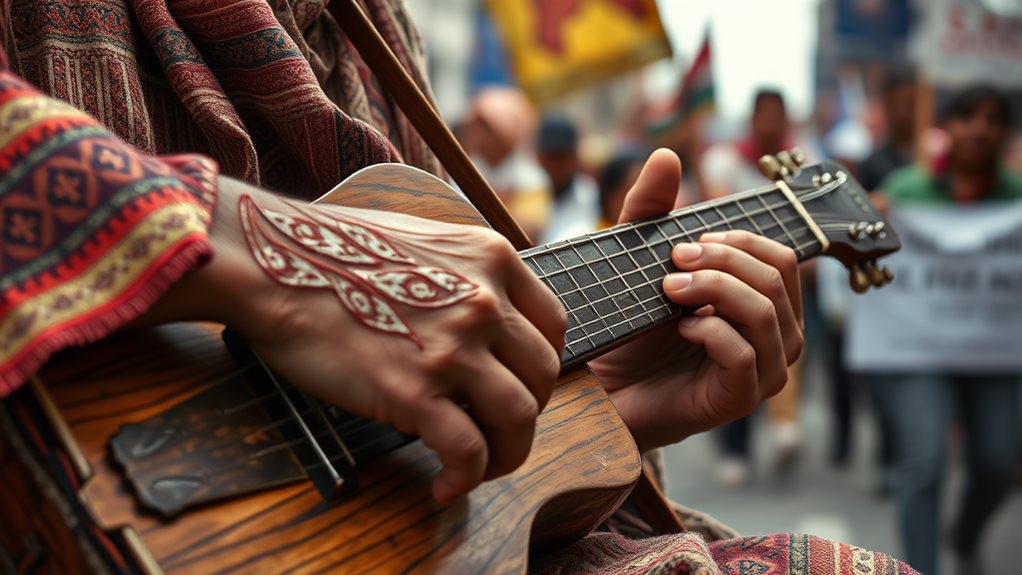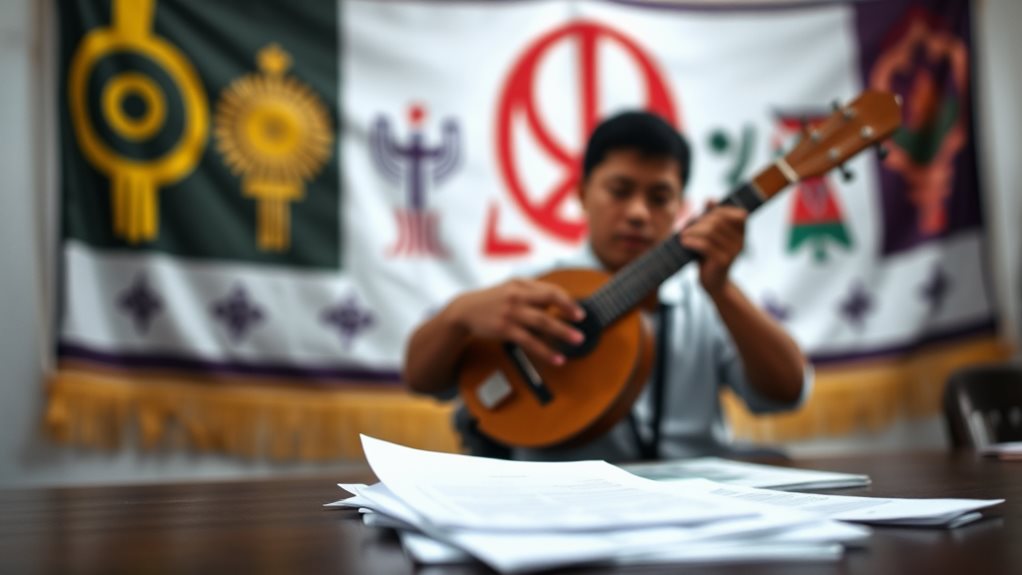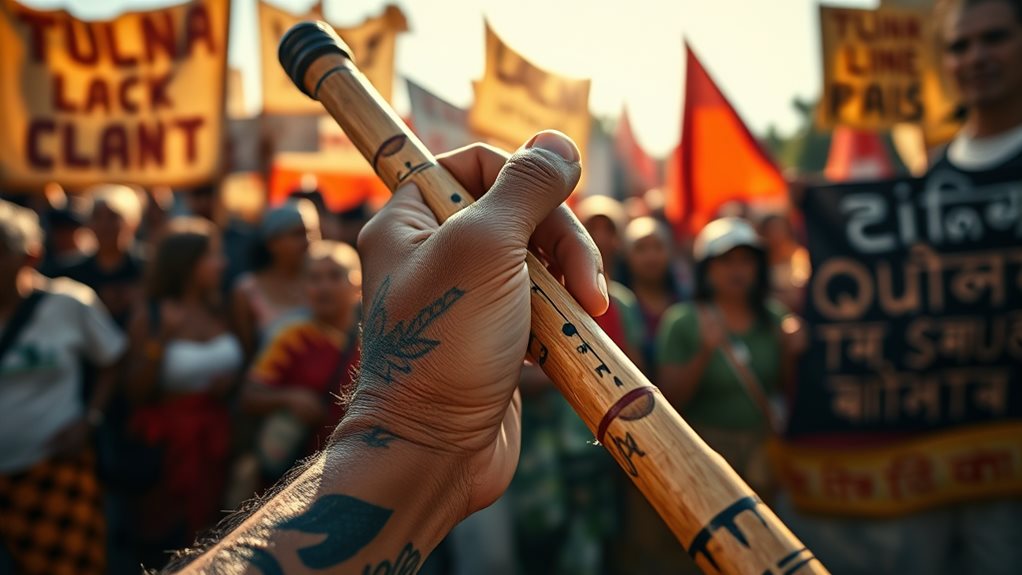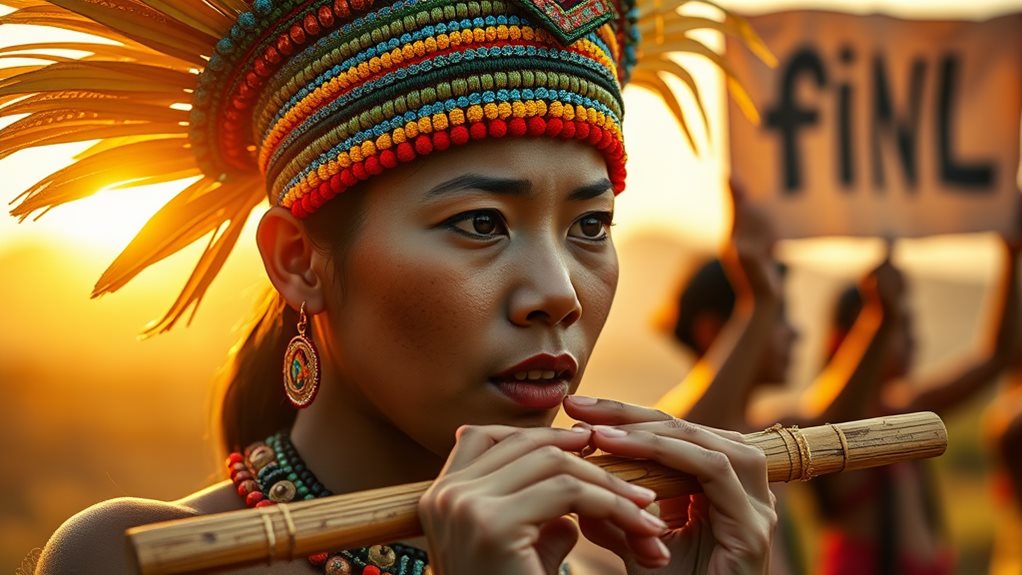Music plays a vital role in Philippine indigenous rights movements. It helps preserve cultural heritage by promoting shared identity and creating economic opportunities through cultural tourism. For example, the T'boli people of Mindanao showcase their traditional music and dance to tourists, generating income and pride in their cultural traditions.
Music is a powerful tool for raising awareness and advocating for indigenous rights. Protest songs and musical narratives bring attention to issues like land rights, which are enshrined in the Indigenous Peoples' Rights Act (IPRA). The song "Lupa at Langit" by the Philippine indigenous group Kalinga, for instance, highlights the struggle for ancestral land and self-determination.
Cross-cultural collaborations are essential in expanding the reach of indigenous music. These collaborations foster innovation while preserving traditional music styles. The fusion of indigenous music with modern genres, such as rock and pop, has created a new wave of indigenous artists who appeal to a broader audience. This, in turn, raises awareness about indigenous issues and promotes cultural understanding.
The combination of cultural preservation, community building, and political action is crucial in the ongoing struggle for indigenous rights. Music has become an integral part of this struggle, empowering indigenous communities to assert their rights and defend their cultural heritage.
Preserving Cultural Heritage

Preserving Cultural Heritage through Music
In Philippine Indigenous communities, music plays a vital role in maintaining cultural identity. Cultural documentation is essential for preserving this heritage. The kulintang ensemble, consisting of five traditional instruments – kulintang, agung, dabakan, babandir, and gangingan – is a prime example. These instruments are crucial for the unique sound of Indigenous Filipino music, and their preservation requires hands-on teaching, ensuring direct engagement with the instruments themselves.
This active learning helps retain Indigenous practices, resisting external influences.
Comprehensive cultural documentation is crucial for preserving cultural heritage**. Video recordings** and archives, such as those found in the Samar Island Natural Park archives, capture the wisdom of elders and their cultural practices. Research initiatives, like *MusikaPilipinas*, meticulously map and define the Philippine music industry, including its socio-cultural and economic dimensions.
Archival materials – documents and recordings – are invaluable for understanding and preserving the history of Indigenous music. Digital archiving makes this heritage accessible to wider audiences and future generations; collaborations between universities and research institutions are key in this endeavor.
Effective preservation incorporates the use of traditional instruments within ongoing cultural practices****. This approach ensures the continuation of cultural heritage and prevents the loss of Indigenous traditions.
Empowering Indigenous Communities
Preserving Indigenous Musical Heritage Empowers Communities
Preserving Indigenous musical heritage is a powerful tool for community empowerment that goes beyond documentation. Music workshops facilitate cultural memory recall** by encouraging community storytelling and the sharing of knowledge through hands-on instrument handling and peer teaching. This approach fosters a sense of shared musical identity** as community members participate in new music composition and professional recordings, strengthening their cultural self-definition.
Traditional Music Education Innovates for the Future
Promoting traditional music education isn't just about rote learning; it's about engaging with the past while innovating for the future. Hands-on teaching methods and the incorporation of modern genres alongside traditional ones enrich cultural expression, strengthening community bonds through shared experiences.
For example, active participation in cultural festivals and rituals**** connects community members with diaspora communities, strengthening their storytelling and musical identity.
Community Engagement Fosters Collective Identity****
Community engagement extends beyond workshops, involving collaborative projects that foster a sense of collective identity. Collective inquiry and experimentation, grounded in social history, strengthen community members' sense of belonging and allow for the exploration of their musical identity.
For instance, creating sustainable livelihoods through tourism and cultural performances**** while preserving traditional methods and ecological sustainability empowers communities to shape their own future.
Legal and Political Advocacy

The Philippines has established legal frameworks to protect indigenous peoples' rights, but significant challenges remain.
The Indigenous Peoples Rights Act (IPRA) of 1997 recognizes ancestral land rights and self-determination, but faces enforcement issues**. The National Commission on Indigenous Peoples (NCIP), tasked with overseeing these rights, has been criticized for its ineffectiveness**.
Litigation strategies are vital tools in protecting ancestral lands. However, indigenous communities often lack the resources to engage in protracted legal battles.
Policy advocacy, driven by organizations like the Cordillera Peoples' Alliance (CPA), has played a crucial role in shaping legislation. The CPA's successful lobbying for IPRA's inclusion demonstrates the power of sustained advocacy.
Threats against advocacy efforts exist, including red-tagging and violence against activists.
The Bangsamoro Organic Law (BOL) offers a different model, granting the Bangsamoro government considerable authority over indigenous rights within its territory. This involves a shift in focus from national policy advocacy towards regional legislative action to address local jurisdictional challenges.
International support helps mitigate some threats, providing indigenous communities with crucial external backing for both litigation strategies and broader policy advocacy efforts.
Cultural Exchange and Innovation
Indigenous Filipino Music: A Balance of Tradition and Innovation
Indigenous Filipino music, particularly kulintang, demonstrates a dynamic interplay between tradition and innovation, actively shaping how cultural heritage is maintained and disseminated. The instruments—kulintang gongs, agung, dabakan, babandir, and gangingan—are central to preserving this tradition. This isn't solely about rote learning; it's about hands-on teaching and imitation, fostering a deep connection to the music's cultural significance.
Kulintang Music as a Symbol of Indigenous Identity
Kulintang music, used in various festivities, functions as a potent symbol of Indigenous identity. For example, it is often played during rituals, ceremonies, and celebrations, emphasizing its importance in Filipino cultural heritage.
Cross-Cultural Collaborations: Preserving Tradition and Attracting New Audiences
Cross-cultural collaborations are transforming how this music is experienced. Modern musicians are incorporating kulintang into contemporary genres, creating exciting traditional adaptations, while ensuring respectful context. These innovations are keeping the tradition relevant to younger audiences.
Types of Collaborations and Their Impact
| Type of Collaboration | Description | Impact |
|---|---|---|
| International collaborations | Filipino musicians abroad working with local artists | Expands the music's reach, preserving traditions in the diaspora |
| Local collaborations | Universities, organizations in the Cordillera | Supports teaching, research, and community engagement |
| Cross-genre collaborations | Blending kulintang with hip-hop, R&B, electronic music | Attracts new audiences, creates unique soundscapes |
| Intergenerational collaborations | Master musicians mentoring young people | Ensures the continuity of traditional knowledge and performance |
| Community-based collaborations | Festivals, workshops, performances engaging local communities | Raises awareness, strengthens cultural identity |
The Power of Music: Building Bridges and Celebrating Diversity
These collaborations aren't simply about blending sounds; they're about building bridges, fostering understanding, and celebrating diverse cultural expressions. The ability of music to transcend boundaries and connect people across generations and cultures is a powerful tool for cultural exchange and innovation.
Economic and Social Impact

The preservation of Filipino indigenous music has significant economic benefits. Revenue is generated through sales of recordings and performances, directly supporting local economies. For instance, the folklorization of traditions like the Maguindanao kulintang attracts cultural tourism, further boosting economic activity within indigenous communities.
Government initiatives, such as the Philippine Creative Industry Law (PCIL), aim to foster economic sustainability within the creative sector, including indigenous music, through strategic funding and planning.
Moreover, music often underscores the importance of protecting ancestral lands, crucial for the economic well-being of communities threatened by unsustainable practices like mining and logging. This economic empowerment, facilitated by music, strengthens indigenous communities' ability to defend their land rights against external pressures.
The power of music also raises awareness about indigenous struggles and rights, influencing public opinion and policy. It fosters community unity and cultural identity, particularly amidst urbanization and external threats.
Protest songs conveying messages against violence and oppression contribute to social movements, stimulating public engagement and activism. Music workshops and recordings validate indigenous cultural practices, offering platforms for storytelling and preserving historical knowledge. This ensures intergenerational transmission of cultural practices, maintaining continuity.
Music becomes a central tool in promoting cultural tourism, showcasing the richness and diversity of Philippine indigenous cultures, and contributing to their economic sustainability.
Educational Community Engagement
Educational initiatives are crucial in preserving and promoting Philippine indigenous music**. These initiatives foster community engagement and intergenerational knowledge transfer through community workshops**.
Participatory learning methods are used in these workshops, where hands-on instruction and peer-to-peer learning encourage immediate instrument engagement. For example, workshops often focus on traditional instruments like the kulintang, blending traditional and contemporary musical forms.
The success of these programs relies on mentorship from master musicians****. They pass down knowledge through demonstration and direct instruction. Initiatives like the House of Gongs combine traditional methodologies with innovative approaches, such as video recording and archiving, to preserve indigenous wisdom.
This documentation ensures the transmission of cultural expressions across generations, safeguarding them for posterity.
Collaborative projects with universities and community organizations amplify the impact. These partnerships increase the engagement of younger generations through community workshops and educational programs.
The integration of modern elements, while preserving authenticity, ensures the continued relevance of indigenous music. This approach emphasizes accountability in maintaining tradition while embracing innovation.
The Future of Indigenous Music

Preservation is key to the future of Philippine indigenous music. To achieve this, it's essential to prioritize digital preservation by meticulously archiving audio and video recordings of traditional performances and the knowledge of elders. This involves supporting community-led initiatives and promoting instrumental heritage, such as the kulintang.
Community engagement is vital. Actively engaging communities is necessary to foster intergenerational transmission of musical skills and the production of traditional instruments. This can be achieved by supporting community-led initiatives and promoting instrumental heritage.
Adaptation to modern contexts is necessary. The adaptation of indigenous music to modern contexts is crucial. This can be done by exploring global fusion, integrating traditional sounds into contemporary genres. For example, collaborations with artists from diverse backgrounds can leverage technology to expand reach and accessibility via streaming platforms.
However, it's essential to address the economic implications of this fusion, including low payouts from streaming services.
Policy support is essential. Stronger legislative frameworks are necessary to protect intellectual property rights and provide funding for research, documentation, and educational programs focused on indigenous music.
Comprehensive research, such as Musika Pilipinas, can inform policy decisions and ensure that support mechanisms are evidence-based. This includes prioritizing digital preservation strategies within these policy frameworks.
Questions and Answers
What Specific Legal Cases Used Music as Evidence?
Specific legal cases have used music as evidence.
One notable example is the "Blurred Lines" copyright infringement case. In 2015, the jury ruled that Robin Thicke and Pharrell Williams' song "Blurred Lines" infringed on Marvin Gaye's 1977 song "Got to Give It Up." The court considered the similarities in the songs' melodies, harmonies, and rhythms as evidence.
Another example is the "Stairway to Heaven" copyright infringement case. In 2016, the jury ruled that Led Zeppelin's iconic song "Stairway to Heaven" did not infringe on Spirit's 1968 song "Taurus." The court analyzed the songs' musical compositions, including their guitar intros and chord progressions, as evidence.
These cases demonstrate how music can be used as evidence in legal disputes, highlighting the importance of copyright law in the music industry.
How Does Music Affect Inter-Tribal Relations?
Music plays a significant role in fostering inter-tribal relations. When different tribes come together to share and celebrate their unique cultural expressions through music, it strengthens community bonding and promotes understanding among diverse groups. For example, in Africa, the Festival in the Desert brings together Tuareg and other tribes from across the Sahara region to share their traditional music and dance, promoting cross-cultural understanding and cooperation. Similarly, in North America, the Powwow gatherings bring together Native American tribes to celebrate their rich cultural heritage through music, dance, and storytelling, fostering unity and mutual respect among participating tribes.
What Are the Ethical Considerations of Music Commercialization?
Commercializing music raises ethical concerns that must be addressed. When music is commercialized, it's essential to consider the cultural context and authenticity of the music. Cultural appropriation, where one culture takes and uses elements of another culture without permission or proper understanding, is a significant ethical concern. For example, a music artist using traditional African rhythms without giving proper credit or compensation to the original creators is an instance of cultural appropriation.
Fair profit sharing models are crucial for equitable compensation. This means that all contributors to the music, including songwriters, producers, and performers, should receive a fair share of the profits. A fair profit sharing model ensures that everyone involved in creating the music is compensated appropriately, avoiding exploitation of any individual or group.
How Is Music Used in Healing Ceremonies?
Music plays a vital role in Philippine healing ceremonies. In these ceremonies, music is used to summon spirits, believed to facilitate the healing process. For instance, in some rituals, shamans use specific melodies to call upon ancestral spirits, seeking their guidance and assistance. Music also aids in conflict resolution by creating a calm atmosphere, allowing participants to open up and resolve disputes peacefully. Furthermore, music promotes community cohesion by bringing people together, fostering a sense of unity and collective healing.
What Role Do Women Play in Indigenous Music?
Women play a vital role in indigenous music, actively participating in cultural preservation and female empowerment. They shape the creation, performance, and transmission of indigenous music in various ways. For instance, in many indigenous cultures, women are the primary keepers of traditional songs and stories, passing them down to younger generations through oral tradition. Additionally, women often take on leadership roles in music and dance performances, showcasing their cultural heritage and promoting cultural understanding. By doing so, they not only preserve their cultural identity but also empower other women to take pride in their heritage.